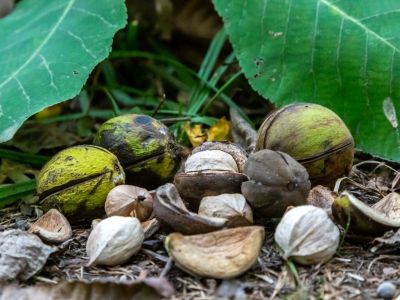A casual stroll in your local forest may find you surrounded by several types of hickory and their attending nut crop. Hickory nut harvesting is a fun, family activity that will provide you with a supply of these high-protein nuts to last through the winter.
Best Time for Hickory Nut Harvesting
Hickory trees have dense, sweet nuts that are reminiscent of mild walnuts. The nut meat is hard to get to because of the hard, thick shells, but once you finally get a taste of these buttery nuts you’ll be hooked. The trees are also sources of sap that can be cooked down for a syrup, much like maple trees and for their wood, both for tools and for smoking foods. If you are lucky enough to live in a region with hickory trees, grab a heavy sack and some hiking boots and learn how to harvest hickory nut trees. The beautiful autumn walk and vigorous crisp air are only part of the reward. Pounds of rich nuts can be a part of your winter diet practically for free. Fall is when you may find forest floors littered with thick hickory nut shells. The brown to gray hard-husked nuts are ripe in autumn and will start raining down during storms and windy periods. You can also try shaking a tree for a bounty of nuts, but be careful about standing right under your harvest, as you might take a hard knock on your head for your efforts. In areas of the eastern United States, hickory trees are common in mixed forests. There are some species that are used as public use plants in parks and open spaces but most are in deciduous and mixed forests in the wild. Hickories have a bumper crop about every three years, but each year will see some production.
How to Harvest Hickory Nut Trees
The nuts are heavy and oily so a thick, heavy-duty sack or crate is recommended. Once you find a hickory grove, harvesting is a snap. Check the ground nuts for any that are intact except for a slight crack. Pick up those that are relatively unblemished and have no rotten spots. Remove husks as you harvest to allow them to compost back into the earth and enrich the soil around the tree. The ideal nut will have a brownish-gray husk and the interior shell will be a rich chestnut brown. If you are in a densely treed area with larger trees protecting the hickory, you may have to shake the plant to remove the nuts. Be cautious about climbing trees to shake them.
Tips on Storing Hickory Nuts
Once you have your bounty, properly storing hickory nuts will ensure they last a long time. Separate the wheat from the chaff, so to speak, by putting the nuts in buckets of water. Discard any that float. The nut meats will not be edible. Lay recently harvested nuts out in a warm area to completely dry. Once nuts are dry, usually after a couple of weeks, you can hold them in a cool area (like the basement or a root cellar) for up to a month, as long as the area is dry and the nuts get good airflow. Alternatively, you may shell the nuts and freeze the nut meats for months.
Hickory Nut Uses
One of the most obvious hickory nut uses is to simply eat them out of hand. Shelling can prove to be a challenge, but once you get into the sweet buttery meat, you’ll have trouble halting your snacking. Nutmeats are useful in any recipe calling for pecans or walnuts. You can also soak the nutmeats in brined water and then roast them for a salty, crunchy flavor. They can also be roasted in a low oven but the flavor isn’t as rich as directly roasted meats. If you are going on a shelling spree to store or freeze the nut meats, don’t throw away those shells. They are high in oils but hard as rocks and burn slowly and evenly. Add them to the fireplace for a delicate hickory scent or throw them on the BBQ to add subtle hickory flavor to meats.
